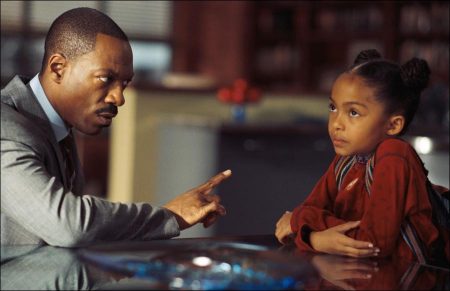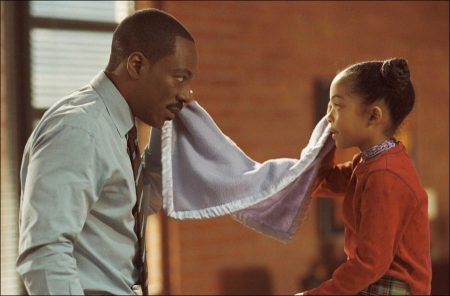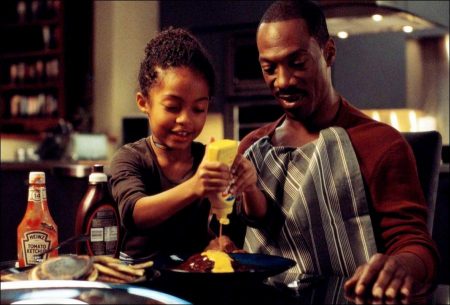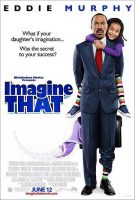Tagline: What if your daughter’s imagination… Was the secret to your success?
Like many busy professionals, Evan Danielson (Eddie Murphy) is so focused on his career that quality time with his young daughter, Olivia (Yara Shahidi), has fallen by the wayside. When an important promotion is suddenly within reach, stressed-out Evan starts to fall apart while trying to fend off his company rival (Thomas Haden Church). But when little Olivia introduces him to the inhabitants of her imaginary land, Evan rediscovers his inner child and finds the answers to all his problems.
Before he found himself standing in front of his friends’ house yelling for his daughter’s purple security blanket in the middle of the night, Evan Danielson (Eddie Murphy) was just your average financial wizard – focused, successful and driven. But when his daughter introduced him to the princesses and their queen living in her imaginary world, Evan followed her on a hilarious adventure that forced him to reexamine the value of their relationship and redefine his meaning of success.
In Paramount Pictures and Nickelodeon Movies’ family comedy “Imagine That,” Evan and his seven-year-old daughter Olivia (Yara Shahidi) find it impossible to connect. He’s too distracted by his career demands to understand the value of quality father-daughter time and she has all but given up on her Daddy. When the promotion of a lifetime is suddenly within his reach, Evan finds himself torn between his parental responsibilities and staving off his company rival, the annoyingly pseudo-mystical Johnny Whitefeather. Evan has always been a man in complete control, but when he really starts to lose it, Olivia steps in with her own bit of advice – winning stock tips courtesy of the princesses and queen who she visits through her security blanket – her “Goo-Gaa.”
Paramount Pictures and Nickelodeon Movies Present a di Bonaventura Pictures Production “Imagine That” starring Eddie Murphy, Thomas Haden Church, Yara Shahidi, Nicole Ari Parker, Ronny Cox and Martin Sheen. Karey Kirkpatrick directs the film from a screenplay written by Ed Solomon & Chris Matheson. The film is produced by Lorenzo di Bonaventura and Ed Solomon. Ric Kidney is the executive producer. The director of photography is John Lindley, ASC. The production designer is William Arnold. The film editor is David Moritz. The costume designer is Ruth E. Carter. The music is by Mark Mancina. The film has been rated PG for some mild language and brief questionable behavior.
Imagining “Imagine That”
“Soppida’s Dragon! Please let me pass!” – Evan
Evan Danielson’s (Eddie Murphy) life, like that of so many parents today, can sometimes be all work and no play. He listens to his daughter without hearing her, is absent even when he’s present. Without meaning to, he is neglecting his parental responsibilities as he chases career advancement. Never in his wildest dreams would it dawn on him that the secret to his success might spring from the imagination of his young daughter, Olivia (Yara Shahidi). This is the world conjured up in the inventive new family comedy from Paramount Pictures and Nickelodeon Movies, “Imagine That.”
Ed Solomon, a busy writer and producer, was taking his six-year-old son Evan to school. In true out-of-the-mouth-of-babes fashion, Evan said something it took weeks for Solomon to truly hear, but when he finally did, it proved to be the inspiration for “Imagine That.”
“While driving with my son,” recalls Solomon, “I had to do something I usually don’t do – make a phone call while he was in the car with me. Afterwards, I apologized and explained that I was in the middle of a business crisis that required immediate attention. The person on the other end was not being pleasant, and asking for things that were unfair. Evan simply said, ‘Why don’t you just kick him out?’ I went on to explain in detail how that wasn’t an option and why. I thought it was cute that he had such a straightforward, but clearly uninformed, answer. Three weeks later, with still no resolution to this problem, we actually had to fire the person. A few days later, he returned and apologized for being unfair and we proceeded to finish our work together.
As Solomon developed the idea, he adjusted it to create a fresh and different look at a particular family dynamic. “The father-son relationship immediately bored me because, first of all, it seemed really pedestrian and, secondly, there are so many movies about fathers and sons. But then I thought about my daughter, who is a formidable presence and whose powerful feminine spirit is sometimes a bit intimidating for me. I remembered her vibrant imaginary world and realized that a father-daughter story would show the story from a unique perspective and that if the source of her business insight was the characters from within her imaginary world, the entire film would be much more magical and, hopefully, more special.”
Enter the “Goo-Gaa.”
“My daughter has a purple blanket,” continues Solomon. The security comforter was the inspiration for the Goo-Gaa that belongs to the main character’s daughter Olivia and is the wellspring for her imaginary world. “I thought the comedic hook could be that only Olivia has access to these imaginary characters and only through this blanket,” Solomon adds. “Now I had a story about a guy who resents the heck out of the fact that his daughter carries around a security blanket everywhere she goes and he does everything he can to separate her from it. When he finds out that it may actually have magic powers that will help him succeed in his career, his attitude suddenly changes.”
Producer Lorenzo di Bonaventura and Solomon have been friends for years. When the idea for the story came up during a vacation, there was an immediate connection. Both men have young children and had been looking to work together on a project for a long time. “Imagine That” seemed to be the right project at the right time.
“Ed and I were on a family whitewater rafting trip together,” recalls di Bonaventura, “and he told me about the fantasy world his daughter had created. As we spoke, Ed began to shape the story.”
Several months later, Solomon turned to another friend and fellow writer, Chris Matheson, to help him write the screenplay. Matheson previously co-wrote the hit comedies “Bill & Ted’s Excellent Adventure” and “Bill & Ted’s Bogus Journey” with Solomon.
“Chris and I were working on an animated project for the internet and had been looking for a new film to write together,” Solomon adds. “After I sold Lorenzo on the idea, I suggested we bring Chris in to write it with me.”
Imagine That Perfect Ensemble
“Hi Moppida and Koopida. I’m Mr. Danielson. I’m Olivia’s Dad” – Evan
The emotional core of “Imagine That” was the relationship between Evan and his daughter, Olivia, and the Goo-Gaa fantasy that ultimately brings them together. The role of Evan would require a balance of playing an ordinary parent who suddenly finds himself in extraordinary and comical circumstances. The actor would need to be someone with a flawless sense of comedy and a proven track record in family comedy, as well as his own magical ability to concoct original and memorable characters. Sounds like a job for Eddie Murphy.
“After the second draft was finished, we contacted Eddie and sent him the script,” recalls di Bonaventura. “Eddie was exactly the character we imagined. His ability to convey a range of emotions was crucial and, of course, his comedic versatility is without peer.”
Both di Bonaventura and Solomon quickly discovered that the Oscar-nominated star of “Dreamgirls” and the wildly successful “Shrek” and “Dr. Dolittle” franchises took an immediate liking to the script. “I responded to the story of ‘Imagine That’ emotionally,” says Murphy. “I found it to be a sweet emotional piece, and it also offered the opportunity to find some funny moments.”
Solomon was impressed with Murphy’s instincts and his unique approach to the role of Evan Danielson. “Eddie knows how to be truthful and play the tiniest of moments with genuine poignancy,” he adds. “Yet he never gets maudlin or sappy. Then, when the story calls for broadness and comic desperation, Eddie is never afraid to go all out without ever going over the top. At every stage, he is perfectly modulated. There’s only one word for him, awesome.”
Murphy smiles, “I really got into the spirit of this story. It’s a movie about a man who starts off feeling like he’s been cursed with this oddly imaginative child. But, in the end, he realizes that he’s truly blessed to have such a wonderfully unique daughter in his life. Evan was a nicely defined and nuanced character, who grows throughout the story.”
With Murphy anchoring “Imagine That,” the producers began their search for a director who could bring to the project the right balance of humor, sensitivity and emotional honesty. Although this would be his first time at the helm of a live-action film, Karey Kirkpatrick was the clear-cut choice.
As a writer, Kirkpatrick had created family-friendly fare that displayed heart and humor, including the Golden Globe-nominated film “Chicken Run,” “The Hitchhiker’s Guide to the Galaxy” and the wildly popular “Over the Hedge.”
Di Bonaventura explains, “From the first meeting with Karey, he fundamentally understood the movie we were trying to make. But what really sold us was that in each subsequent meeting he brought in new ideas and was able to shape them in a collaborative way. His background was pitch-perfect for reaching the widest possible audience we felt this movie could appeal to.”
Moving forward with its ensemble cast, the filmmakers sought out Oscar®-nominated actor Thomas Haden Church (“Sideways”) to portray Evan’s archrival, Johnny Whitefeather. The recent Emmy Award winner for Walter Hill’s “Broken Trail” (for which he also earned Golden Globe and Screen Actors Guild Award nominations) is blessed with a signature voice and sense of humor that would add considerable dimension to his role of the not-quite-who-he-seems Whitefeather. Church had already worked with Kirkpatrick previously on “Over the Hedge” and “Charlotte’s Web,” which re-affirmed his confidence that Kirkpatrick would be able to guide this project with the same skill and understanding he provided on their previous collaborations.
“The only way you’re going to establish the necessary trust bond with a director,” offers Haden Church, “especially with a first-time director, is to be confident they know what they’re doing. And I came into the movie certain of this, having worked with Karey on two other pictures. Even though those films were animated features, he knows how to make adjustments in the moment. He’s very precise in directing performance.”
Finding a child actor to fill a pivotal role in a film is always a challenge, and casting the ideal Olivia proved to be no exception. The part demanded a youngster with personality and natural innocence who also had stamina, since she is in more than half the film’s scenes. Add to that the pressure of being confident enough to share those scenes with a powerhouse talent like Murphy. The needle-in-a-haystack assignment of finding that spot-on young actress fell to casting director Jeanne McCarthy, who instituted a national search.
More than 3,000 young hopefuls were either submitted through agencies or tried their luck at an open call in Los Angeles. Casting sessions were also held through agencies in Miami, Texas, New York, Chicago and Washington, DC. After culling through hundreds of candidates, the search was narrowed to five hopefuls, who came to Los Angeles for screen tests and meetings. The top three finalists were tested opposite Murphy.
L.A.’s own Yara Shahidi clicked with Murphy, winning the hearts of the star and the filmmakers. “Imagine That” marks her feature film debut. Recalls Murphy, “I first read with her and the other girls. All of them were adorable, but Yara was the most special. Something just clicked between us.”
“Yara has that most elusive of qualities – star power,” says di Bonaventura. “The screen absolutely lights up when she’s on. Her chemistry with Eddie was immediate and her ability to take direction astounded us.”
Relishing the task of serving a memorable meal of condiment-heavy pancakes to a cultural icon – one of her favorite scenes – was an unforgettable moment for the young Shahidi. Her thoughts on their first meeting? “Mr. Eddie is super funny in person,” Shahidi giggles. “It was great working with him! He is really, really nice… and smart!”
Rounding out the ensemble are Nicole Ari Parker, Ronny Cox, DeRay Davis and, in a special appearance, Martin Sheen.
Multi-talented actress Nicole Ari Parker was cast as Trish, Evan’s wife, from whom he is separated. Best known for work in such films as “Remember the Titans” and the “Soul Food” TV series, Parker found much to appreciate in her role.
“I was so excited,” offers Parker candidly, “because a lot of people write the wife or the ex-wife as someone with nothing to say or as a real pill, which is supposed to explain why she’s the ex-wife. But with Trish, the writers took the trouble to really develop her character. They gave her a real personality and let us see the situation from her perspective as well.”
Veteran performer Ronny Cox plays Evan’s boss, Mr. Stevens. With over a hundred films to his credit, Cox here is reunited with Murphy, with whom he worked as Lieutenant Bogomil in “Beverly Hills Cop” and “Beverly Hills Cop II.” The actor knew the challenges ahead could only enhance the final film.
“I knew the problem they were going to have with this film,” Cox says. “It was that it would be so funny it would be hard to settle on which take to use. If they ever put together a reel where they just show all the stuff that’s not in the film, it could be a hit film in itself.”
The talents of stand-up comedian/actor DeRay Davis as John, one of Evan’s best friends, are immediately evident in the scenes in which he tries to psychoanalyze his overworked buddy, Evan.
“My character talks to grown men and gets them to find their inner child,” explains Davis. “Hopefully it exists inside of them, and my job is to make it come out. But no one likes it, especially Evan. John helps a lot of the athletes and he is now trying to help Evan connect with his daughter.”
Martin Sheen joins the cast for a small, but pivotal, role as financial guru extraordinaire Dante D’Enzo. “I play this financial tycoon who is kind of a legendary financier,” comments Sheen, “and these lads are vying for an opportunity to be a part of his company. They’re both kind of presenting an audition piece, if you will, and their ideas about what they might do for our company.”
Kirkpatrick and Sheen had several conversations about the character and the names of rich, big business titans were bantered about. Kirkpatrick preferred to think of D’Enzo as more Warren Buffet than Donald Trump, and Sheen agreed.
“Karey said that really powerful men or women don’t have to express it,” recalls Sheen. “Buffett gave most of his fortune away to the Gates Foundation to serve the Third World. I mean, that was a reflection of who he was, and I would like to think that, if I were in that situation, I’d do the same. So he was the image we chose. If Warren Buffet is listening and watching, I hope we did you justice.”
Imagining “That”: About the Design Team
“And Qwali. Thank you for, well, for letting me into your land. Because, honestly, it’s very beautiful and fantastic.” – Evan
Seeking to set “Imagine That” somewhere other than the obvious and overused Los Angeles and New York, the production searched for a believable and appropriately sized city. It would need to be a place that was sophisticated enough to be the home base for a major financial management company and still lend the film a different look.
“We wanted to get out of the L.A.-New York mind-set,” acknowledges di Bonaventura. “We all knew Denver. My sister lives there, as do some friends. We felt it was a big enough city to house a major money-management firm. Also, we liked having a touch of the West, since Thomas Haden Church’s character, Johnny Whitefeather, claims some Native American blood. The main advantage of filming in Denver is that it’s a city that hasn’t been used a lot in films. So there were a lot of choices that looked fresh and inviting.”
Once the creative team began to scout the city for specific exteriors and interiors, the beauty of the city, its architecture and its spectacular vistas, quickly validated their choice to center the story there.
A variety of locations were chosen in and around the Mile-High City, including the historic Brown Palace Hotel in downtown. Built in 1892, the hotel with its unique carved sandstone façade has been host to diverse guests from U.S. presidents such as Teddy Roosevelt and Dwight Eisenhower to pop idols like the Beatles. Another of the production’s locations, built in the late 1890s and also designed by architect Frank Edbrooke, was the George Schleier Mansion, which stood in as Trish’s place of business.
Additionally, the Pepsi Center, home of the Denver Nuggets basketball team, was the site of a scene featuring Nuggets players Allen Iverson and Carmelo Anthony, who played themselves in the film.
Kirkpatrick was keen to surround himself with a group of top creative behind-the-scenes craftsmen. “The key to directing,” he says, “is to hire a lot of people who know a lot more than you, and let them do what they do.”
Assisting Kirkpatrick on every shot was director of photography John Lindley, whom Kirkpatrick referred to as his “right-hand man,” and who was crucial in helping the director bring his vision to the screen. “John shot one of my top-ten favorite movies of all time, ‘Field of Dreams,'” Kirkpatrick says. “I could not have done this film without him. If you like the way this movie looks, you have to credit John. And even more than that, he has incredible story sense and a great feel for, not just pretty pictures, but the best way to use the camera to tell the story emotionally. He was an absolutely invaluable creative partner.”
In addition to Lindley, Kirkpatrick’s creative team included Academy Award nominated (for “Malcolm X” and “Amistad”) costume designer Ruth E. Carter and noted production designer William Arnold. “We started working about 12 weeks before shooting began,” recalls Arnold. “We scouted Denver and Los Angeles to decide what would be shot where.”
Many of the film’s interiors were shot on the soundstages at Paramount Studios in Hollywood. None of them was more important to the story than Evan’s loft. A man of good taste and money, Evan’s apartment, as well as the suits he wears, needed to reflect his elegant, yet understated, style.
“The design for Evan’s loft was based on scouting some of Denver’s new luxury loft properties,” explains Arnold. “We felt Evan would have selected a loft with the best view, one that was close to his workplace downtown. He would have had a decorator furnish it with very little personal involvement. He would not be very connected to this space. The emptiness and oversized elements would make Evan look small, maybe even childlike. And as for Olivia, the place is almost overwhelming, not kid-friendly at all.”
In keeping with the open and stark appearance of his apartment, the outfits Murphy wears were clean and sharp as well. Evan’s clothes reflected how he saw himself as a successful and stylish businessman. Throughout the film, he is dressed in classic suits designed for him especially by costume designer Carter, who most recently worked with Murphy on “Meet Dave.” The fabrics for each suit and shirt were carefully selected.
“Eddie’s suits were all designed by me,” says Carter. “I was very careful in selecting the fabrics that were light enough to be worn in Los Angeles, yet had a Midwest texture that would look suitable for a Denver climate.”
Kirkpatrick was involved every step of the way in finalizing all of the design elements for the film – for the sets and for the costumes. And he recognized the importance of color selections in conveying feeling and mood.
“Karey was involved; he really liked the idea of striped tights for Olivia,” continues Carter. “He even requested Evan’s ‘power suit’ in the ranch scene, for it made him seem out of place in the rugged terrain. Karey liked the idea of using grey on Evan when his mood is ‘grey’ because the bottom has fallen out of his life and he’s about to be fired.”
At the other extreme from Evan’s conservative style is that of his bitter rival. Whitefeather’s look could not be more different than his rival in his approach to business and his preference for non-conformist office attire. Of uncertain ethnic background, Whitefeather is, nonetheless, playing the Native American card and his clothes have a distinctly Western feel. Carter found many of Whitefeather’s outfits in well-known Denver outlets, including the Native American Trading Company and Shepler’s Western Super Store.
Carter explains the difference in the two characters this way: “Overall, if one were to compare Evan’s character with that of Whitefeather, you could say that they both, in their own way, had to look the part. Whitefeather adorned his exotic clothing accessories and details with traits of Native American culture, adding credibility to all the Native American metaphors he uses to impress potential investors.”
Ultimately, while audiences may see the movie as a story about a father who learns to slow down and appreciate his daughter, and about the joys of imagination, Murphy wants them to come away with “that little fuzzy warm feeling you get when you’ve seen a good movie,” he says. “You know, how you feel when you’ve had a good time and had some laughs. I don’t want to send you away with a message, just a good feeling. Those are the kinds of movies I make. Good-time movies.”
How the Cast Would “Imagine That”
“You heard me! It’s a sparkly company. And everybody loves sparkly things. So buy it! Because…it’s sparkly!” – Evan
Throughout filming, the actors and filmmakers focused on one of the central themes of “Imagine That,” the presence of imagination in our lives. It’s a gift we all possess as children, and the lucky few who are open to it continue to exercise imagination into adulthood. The best actors and filmmakers possess unfettered imaginations, and help us see the world through its prism. So for the cast and filmmakers of “Imagine That,” the theme of unleashing one’s own imagination at any age was one they immediately took to heart. The following is a peek under their “Goo-Gaas” of inspiration.
Eddie Murphy: “Where would we be if we didn’t have a chance to flex our imagination? Still, some of us tend to forget how to use it as adults because we have so much to deal with in our everyday lives. As a father, I’m always reminded by my children that you can still pretend and imagine. And it’s even better when you spend time with them and create something together.”
Thomas Haden Church: “I think that there is a wonderment, a kind of life-affirming eternal hope that dwells within children and what goes on in their imagination. Things are so mystical and magical to them. There’s an innocence that unfortunately gets diminished as you get older, and it’s just nice to be reminded of it.”
Director Karey Kirkpatrick: “My favorite kind of kid is one with a spark in his or her eyes who is making things up and exploring the world and looking at it from their own unique perspective. With all three of my kids I sometimes see that moment happening and I try to surreptitiously set up a video camera to capture it. But usually they’re hip to me. They see the red light coming on and it goes away. If you step into that world, you can see the way they get shaken out of it because it’s something that’s very private to them. I’m constantly intrigued by what must be going on in their heads. They’re seeing things with an intensity that I’ve forgotten and I envy that. Kids use their mind in imaginative play in order to make sense of the world as they’re starting to live in it, and that’s how they learn how to grasp it.”
Writer/Producer Ed Solomon: “For adults, ‘Imagine That’ is a story about a guy who thinks in terms of numbers and results, then suddenly discovers that he has a golden goose right under his nose. But in order to access the golden eggs, he needs to dive into a world of play and imagination – and a particularly feminine one at that. But for him it’s not really about going into his (or her) imagination; it’s really about a guy who comes to truly see and experience his daughter and the special world she inhabits. That is what truly sets him free as a parent and as a human being. For children, imagination is how they process the complexities of life. They use imagination and play. For a child, this is a story about a little girl whose father doesn’t truly see her. Then she realizes that she has a gift that forces him to see her. It’s the first time she’s ever had any real power over him. The comedy comes from the fact that she is finally able to make him jump through hoops – and she does.”
Producer Lorenzo di Bonaventura: “Having two children has opened my eyes to the wonder of childhood and to the importance, as an adult, of trying to be open to unbridled imagination and enthusiasm. Grown-ups too often limit themselves, simply settling for what is possible. Imagination is about keeping one’s universe as expansive as possible.”
Imagine That (2009)
Directed by: Karey Kirkpatrick
Starring: Eddie Murphy, Thomas Haden Church, Yara Shahidi, Nicole Ari Parker, James Patrick Stuart, Vanessa Williams, Larramie Doc Shaw, Daniel Polo, Marin Hinkle, Marin Hinkle, Stephen Root
Screenplay by: Ed Solomon, Chris Matheson
Production Design by: William Arnold
Cinematography by: John Lindley
Film Editing by: David Moritz
Costume Design by: Ruth E. Carter
Set Decoration by: David Smith
Art Direction by: Sue Chan, Donna J. Hattin
Music by: Mark Mancina
MPAA Rating: PG for some mild language and brief questionable behavior.
Distributed by: Paramount Pictures, Nickelodeon Movies
Release Date: June 12, 2009
Visits: 82







